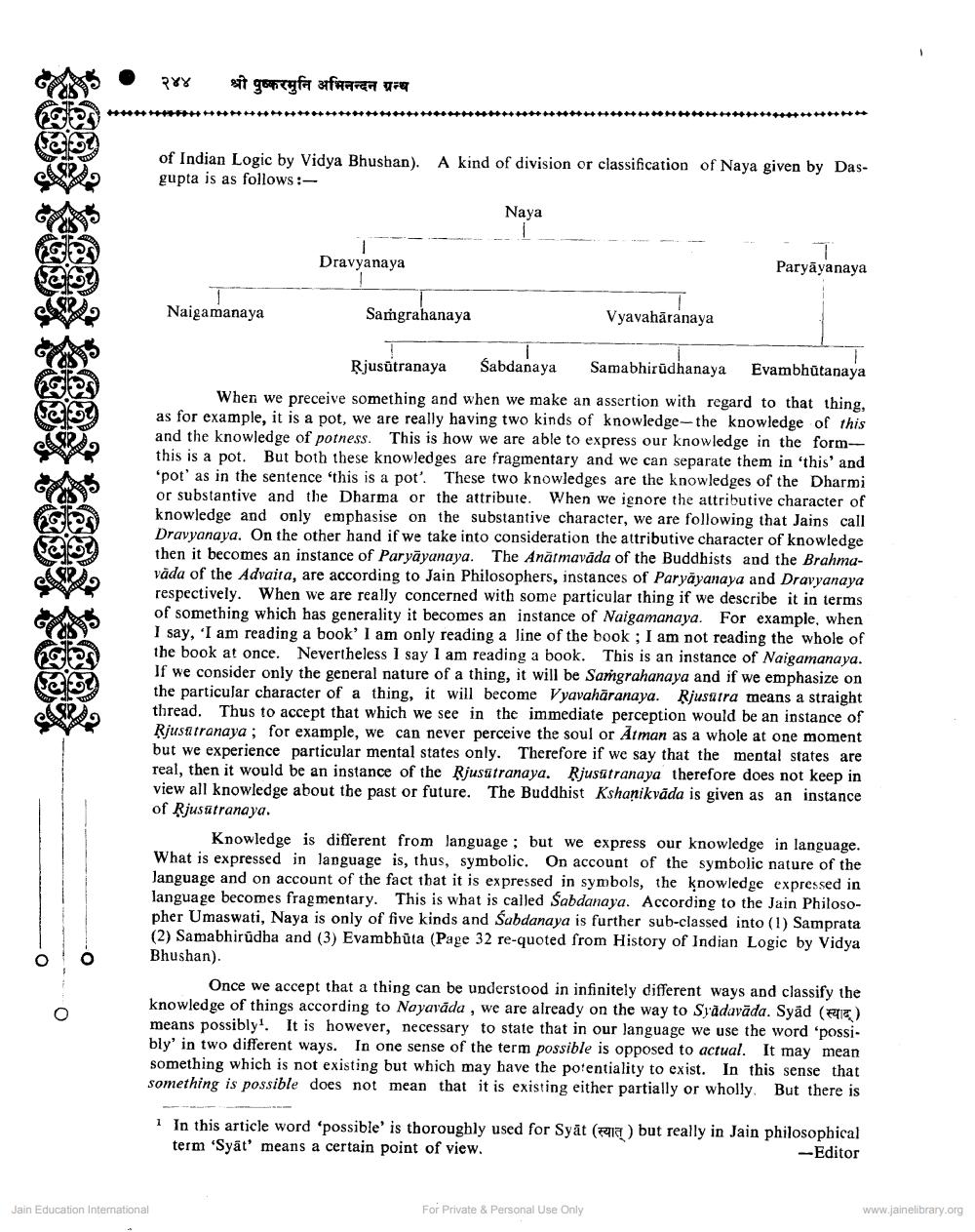________________
·O
२४४
Jain Education International
श्री पुष्करमुनि अभिनन्दन ग्रन्थ
of Indian Logic by Vidya Bhushan). A kind of division or classification of Naya given by Dasgupta is as follows:
T Naigamanaya
Dravyanaya
Samgrahanaya
T Rjusūtranaya
Naya T
Vyavahāranaya
T Paryayanaya
Sabdanaya
Samabhirudhanaya
Evambhutanaya
When we preceive something and when we make an assertion with regard to that thing, as for example, it is a pot, we are really having two kinds of knowledge-the knowledge of this and the knowledge of potness. This is how we are able to express our knowledge in the formthis is a pot. But both these knowledges are fragmentary and we can separate them in 'this' and 'pot' as in the sentence 'this is a pot'. These two knowledges are the knowledges of the Dharmi or substantive and the Dharma or the attribute. When we ignore the attributive character of knowledge and only emphasise on the substantive character, we are following that Jains call Dravyanaya. On the other hand if we take into consideration the attributive character of knowledge then it becomes an instance of Paryayanaya. The Anätmavāda of the Buddhists and the Brahmavada of the Advaita, are according to Jain Philosophers, instances of Paryayanaya and Dravyanaya respectively. When we are really concerned with some particular thing if we describe it in terms of something which has generality it becomes an instance of Naigamanaya. For example, when I say, 'I am reading a book' I am only reading a line of the book; I am not reading the whole of the book at once. Nevertheless I say I am reading a book. This is an instance of Naigamanaya. If we consider only the general nature of a thing, it will be Samgrahanaya and if we emphasize on the particular character of a thing, it will become Vyavaharanaya. Ṛjusutra means a straight thread. Thus to accept that which we see in the immediate perception would be an instance of Rjusatranaya; for example, we can never perceive the soul or Atman as a whole at one moment but we experience particular mental states only. Therefore if we say that the mental states are real, then it would be an instance of the Rjusutranaya. Rjusütranaya therefore does not keep in view all knowledge about the past or future. The Buddhist Kshanikvada is given as an instance of Rjusatranaya.
Knowledge is different from language; but we express our knowledge in language. What is expressed in language is, thus, symbolic. On account of the symbolic nature of the language and on account of the fact that it is expressed in symbols, the knowledge expressed in language becomes fragmentary. This is what is called Sabdanaya. According to the Jain Philosopher Umaswati, Naya is only of five kinds and Śabdanaya is further sub-classed into (1) Samprata (2) Samabhirudha and (3) Evambhūta (Page 32 re-quoted from History of Indian Logic by Vidya Bhushan).
Once we accept that a thing can be understood in infinitely different ways and classify the knowledge of things according to Nayavada, we are already on the way to Syadavāda. Syad () means possibly1. It is however, necessary to state that in our language we use the word 'possibly' in two different ways. In one sense of the term possible is opposed to actual. It may mean something which is not existing but which may have the potentiality to exist. In this sense that something is possible does not mean that it is existing either partially or wholly. But there is
For Private & Personal Use Only
1 In this article word 'possible' is thoroughly used for Syat (a) but really in Jain philosophical term 'Syat' means a certain point of view.
-Editor
www.jainelibrary.org




